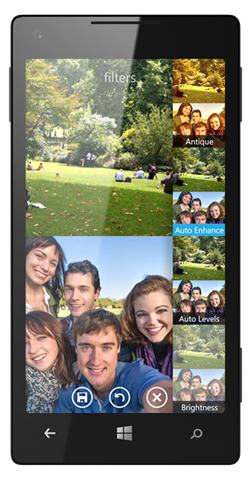“The potential to increase reach across platforms while actually reducing development time makes [Windows Phone 8.1] the most developer-centric release I have witnessed from Microsoft.”
Canadian developer and Microsoft MVP, Sébastien Lachance has been using the Windows 8.1 SDK for two months now and it is his wish come true, he says. The benefits of the converged app model built into the platform afford him the luxury of writing code only once for two major platforms and maximizing outreach potential. Lachance accrued 100,000 downloads for his smash hit app, DualShot, within the first month of its launch and he is eager to take advantage of the Windows Phone 8.1 release to enhance the capabilities of his other apps and to expand their reach. I caught up with him to learn about how he intends to make his apps even more successful on Windows Phone 8.1.
What about the Windows Phone 8.1 release excites you the most?
Having developed for Windows Store and Windows Phone, I know that having to learn only one global set of APIs will help me and a lot of other developers specialize in developing for the Windows platform. The efficacy that this adds to the development process is exponential.
Another benefit of the converged app model is that it will be easier to share and reuse code. Windows Phone and Windows apps now use majority of the same unified controls [both in XAML for apps written in C# and in HTML/WinJS for apps written in JavaScript] and there are now few excuses not to port an app from Windows Phone to Windows and vice-versa. In doing so, the potential to increase reach across platforms while actually reducing development time makes this the most developer centric release I have witnessed from Microsoft.
Also, as a long time user of C# and Visual Studio, I can easily focus on the functionality and user experience instead of the nuts and bolts of making my app work. A variety of free libraries, code snippets, and frameworks make my job easier as well.
Moving forward, I plan to develop on Windows Phone 8.1 exclusively because I’ll be able to develop for two platforms at the same time and market my app on both platforms more easily, thus expanding my reach.
Can you talk more about the success of DualShot and how you plan to use the Windows Phone 8.1 release to take your app to greater levels of success?
I think DualShot offers unique value to its users by allowing them to capture both sides of every story—the one in front of the camera and the one behind. DualShot further integrates with social media, allowing users to share both angles of their pictures with their friends and loved ones online.
While working on an app, I always start with a question: Can I create a mobile application that will make a certain human task more efficient? It’s with this in mind that I created my first two apps—Bridge Companion and Ultimate Poker Manager—to help users track their scores when playing the card games.
In addition to its focus on developers, I believe that the Windows Phone 8.1 release focuses on delivering apps that provide a richer and more effective experience for the user. So the platform aligns strongly with the way I approach app development. Specifically, I love the Windows Phone Live Tile feature and the ability to present actual information from inside the app on an icon on the user’s Start screen. With Windows Phone 8.1, the number of tile templates has exploded and I’m looking forward to using them.
Once you attract a new user, though, you have to retain that user, and providing a good experience is crucial. Most applications are used only once, so it is important to “wow” the user on the very first use. Windows Phone 8.1 provides plenty of features to engage and retain users. The ones I intend to use are the Action Center and the people hub extensibility for social apps.
The ability to engage users using rich features that the Windows platform offers allows us developers to focus on adding value to the users and reduce focus on marketing.
What is your advice for other developers?
Regardless of market success, a developer has to be happy using his or her own app. Developers should also beta test and—build more apps! Apps breed apps—by making more apps and having a diverse portfolio, I’ve secured more contracts.
Developers using Windows Phone 8.1 should make sure their apps look good at all resolutions. Personally, I’d prefer to have an app with fewer features that looks good on my device; I think that applies to most users. You can always add new features via updates.
Follow me (@ArchieCoder) on Twitter!

